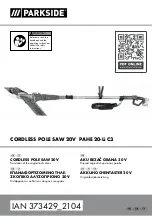
GB/MT
42
TRANSPORT
If the machine must be transported, carry it by the handle
(34 - Fig. 4) and place it in the original packaging in which
it was supplied. In the process, make sure that it is correctly
positioned in the package (see arrows on the package).
If possible, the load should be fixed with ropes or securing
belts in order to prevent shifting during the transport or parts
of the load from falling down.
POSITIONING/WORK STATION
Position the machine on a work bench or on a flat base so
that the machine is supported as stably as possible.
The equipment must be set up where it can stand secure, i.e.
it should be bolted to a workbench, a universal base frame
or similar. When working with the machine, ergonomic fac-
tors must be considered; the ideal height of the work table or
the base is reached when the base surface or the upper work
surface is 90 to 95 cm above the ground. The positioning of
the machine must provide for at least 80 cm of clearance in
all directions and in order to allow for cleaning and repair
work as well as necessary adjustments in observance of
safety conditions and with sufficient room to manoeuvre.
CAUTION:
Position the machine in a zone which is suit-
able in respect to the environmental conditions and lighting.
Never forget that the general environmental conditions play
an extremely important role in accident prevention.
CONNECTION TO THE POWER SUPPLY
Make sure that the socket is in a good condition. We would
like to remind you that the power supply must be connected
to a magnetic-thermal circuit breaker which protects all lines
from short-circuits and overloading.
Area of application
Intended application possibilities
The machine cuts:
• Wood and materials similar to wood
• Plastic
Unintended application possibilities
The machine is not suitable for:
• Ferritic materials, steel and cast iron, as well as other ma-
terial types which are not listed, particularly food.
• Mitre saw without guard.
• Materials larger than the specified cutting data:
90°/90°
/
120 x 60 mm
90°/45°
80 x 60 mm
45°/90°
120 x 35 mm
45°/45°
80 x 35 mm
Settings
CROSS-CUTTING
ATTENTION:
Before carrying out the following adjust-
ments, please check whether the motor of the machine is
switched off.
Pivoting the table plate (Fig. 2)
The mitre saw can be pivoted left and right with the rotary table.
Exact angle adjustment is possible on the basis of the scale.
The angle can be precisely and quickly adjusted from 0° to
45° with locking positions at 15°, 22.5° and 30°.
To pivot the rotary table, loosen the set screw (21) and
rotate the unit using the handle (20) until the desired angle is
reached. Then secure it with the set screw (21).
Tilt of the saw unit (Fig. 3)
The saw unit can be tilted at an angle of up to 45°.
Loosen the handle (23) on the rear side of the machine and
tilt the unit to the desired angle position according to the
scale. The angle can be set on the basis of the scale (24) us-
ing the pointer (25). Then the handle must be re-tightened.
Working instructions
After you have carried out all the tasks described above, you
can begin working.
ATTENTION:
Always keep your hands away from the cut-
ting zone and never attempt to reach in while cutting.
FIXING A WORKPIECE
Clamp the work piece on the work table with the workpiece
clamp (10 - Fig 1) in order to fix it in place.
Cross-cutting (Fig. 1, 1.3, 4)
Attention!
For 90° mitre cuts, the moveable stop rail
(27a) must be fixed in the inner position.
• Open the set screw (27b) on the moveable stop rail
(27a) with an Allen key and push the moveable stop rail
(27a) inwards.
• The moveable stop rail (27a) must be locked in a posi-
tion far enough from the inner position that the distance
between the stop rail (27a) and the saw blade (5) is no
more than 8 mm.
• Before making the cut, check that no collision could occur
between the stop rail (27a) and the saw blade (5).
• Secure the locking lever (27b) again.
• Pressing the machine head lightly downwards and removing
the locking bolt (26) from the motor bracket at the same time
disengages the saw from the lowest position. Swing the ma-
chine head up until the release lever (3) latches into place.
• Lift the saw unit by the handle (2) until it locks in place in
the top position.
• Lock the material with the clamping device (10) on the
fixed saw table to prevent the material from moving dur-
ing the cutting operation.
• Press the workpiece evenly on the stop strips (27); make sure that
you hand remains outside the cutting area of the saw blade.
• With your right hand on the handle (2), press the locking le-
ver (3) so that the unit can also be pivoted downward.
• The motor starts when the start button (1) is pressed.
• Slowly bring the saw blade down to the workpiece and
cut through it with moderate pressure.
• When the cutting operation is completed, move the ma-
chine head back to its upper (home) position and release
the ON/OFF button (1).
Summary of Contents for PKS 1500 A2
Page 5: ...Fig 5 28 29 6 2 3 27 26 1 34 Fig 4 Fig 5 Fig 7 32 31 Fig 7 Fig 6 30 33 Fig 6...
Page 64: ...59 DE AT CH...
Page 66: ...147 148...
















































